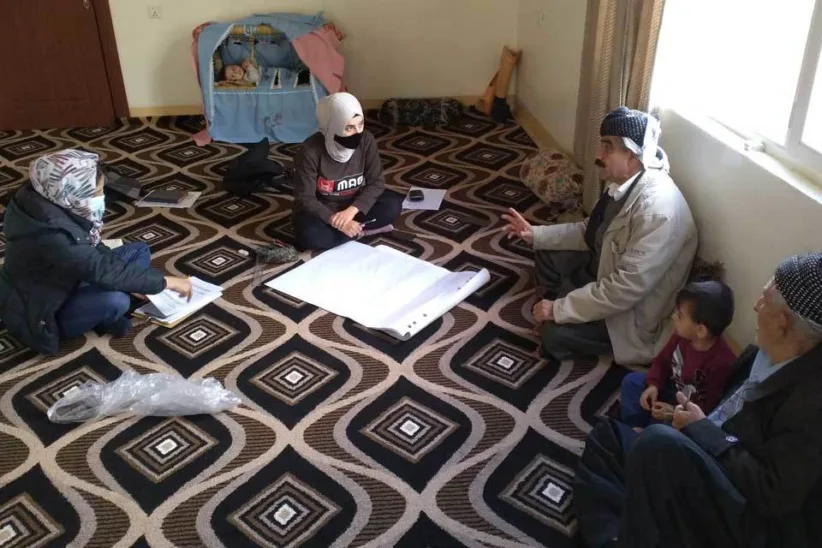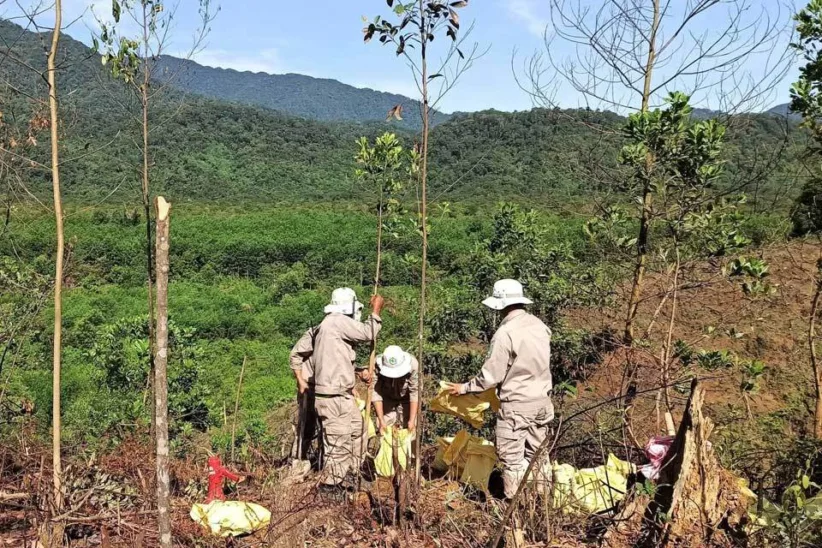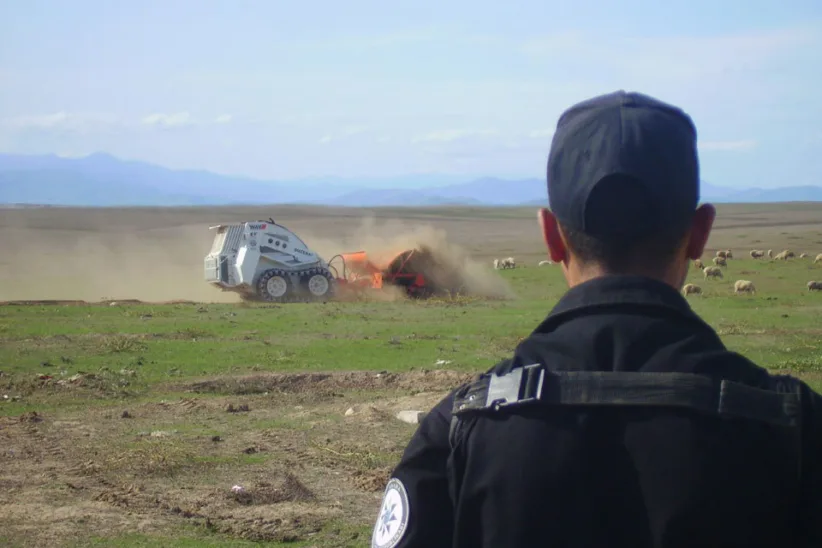Blog: International Women’s Day 2021: Women, mine action and the environment
Women already play a critical role in mine action, with the number of women working in humanitarian demining programmes increasing. Given gender differences in perception and behaviour towards environmental protection, women also have an important role in environmental mainstreaming in the sector. Linsey Cottrell and Kendra Dupuy contacted women working in humanitarian mine action to explore their views on the environmental issues facing mine action and the communities in which they work, the challenges ahead, and hopes for the future. Women working in Azerbaijan, Colombia, Iraq, Sri Lanka, Vietnam and Zimbabwe were interviewed.
Environmental challenges faced by communities
There are many stories of the inspirational women now working across humanitarian demining programmes. There is also increasing and long-overdue attention on the environmental damage caused by the use of explosive weapons, and the legacy from the explosive remnants of war (ERW) – damage that women working in conflict-affected countries have often witnessed first-hand. All the women we interviewed who worked in humanitarian mine action (HMA) felt that environmental issues were important, or very important, and that their attitude towards the importance of the environment has only increased in recent years.
Collectively, their work covers a broad range of mine action activities. This includes community liaison, awareness raising and risk education, gender mainstreaming, victim assistance, surveys and programme management. As put by Roza Sefixanli from the Azerbaijan Campaign to Ban Landmines, this legacy from conflicts has the potential to cause harmful and long-lasting environmental consequences, if not addressed effectively and in a timely fashion.
Noor Ameer works as a Community Liaison Officer in Iraq and through her job with Mines Advisory Group (MAG) realised how much the remnants of war affect the environment for years after. It is no surprise that each is acutely aware of the long-lasting legacy that conflict and ERW have on people and the environment but it is valuable to hear of the specific environmental issues facing different regions. It was widely acknowledged that there is a need for the expediated clearance of ERW to address both their humanitarian impact and the environmental issues they create.

In Colombia, Angelica Pardo and Natalia Morales Campillo from the Colombian Campaign to Ban Landmines explained that working in mine action draws attention to the realities faced by local communities and indigenous people; highlighting their strong relationship to the land, nature and its resources. It also highlighted the serious environmental threats Colombia faces from the exploitation of natural resources. These include deforestation and the loss of natural habitat, the destruction of indigenous peoples’ sacred sites, and the contamination of land and water resources from ERW, legal and illegal mining and oil spills.
For some of our interviewees, their attitude towards the importance of environmental issues has increased because locally, the environmental consequences of climate change are already evident, while the significance of global environmental challenges has become much more apparent in recent years. Demining work is weather dependent. Nillasi Liyanage, a Youth Co-ordinator at the Sri Lanka Campaign to Ban Landmines, described how heavy rain can disrupt and halt work. Programmes have already experienced increased work due to heavy rain causing flooding, moving mines to new areas and requiring community liaison officers to revisit and deliver further mine risk education as new areas become contaminated.
Environmental issues also usually affect marginalised groups of society the most. This means that landmine survivors and their families will be disproportionally impacted from the adverse effects of climate change and environmental harm. Climate change was a common concern for the women we interviewed and its effects on areas contaminated with ERW. With more intense rainfall, and flooding and landslides exacerbated due to deforestation, the problem of floods exposing and moving ERW is likely to intensify as the effects of climate change increase.

Do Thi Thanh Nhan has worked for Norwegian People’s Aid (NPA) since 2011, and is the Provincial Programme Manager for Thua Thien Hue province, Vietnam. The province is ecologically rich and diverse, with 128 kilometres of coastline, 22,000 hectares of lagoons and more than 200,000 hectares of forest. As well as the legacy from ERW, the province and the district of A Luoi was heavily affected by the US military’s use of Agent Orange herbicide from 1961 to 1971. Alongside the massive ecological harm caused by the defoliants at the time, the herbicide contained the highly toxic and persistent dioxin 2,3,7,8 TCDD. After 50 years, dioxin levels in the environment continue to present significant risks to people and the environment. Similarly, in northern Iraq, there is the legacy of environmental risks from ground contaminated from the use of chemical weapons and oil pollution.
ERW can add to these forms of conflict pollution. Where contamination by ERW has been present for many years, such as in Iraq, Vietnam and many other countries, the risk of munitions degrading and munition components leaching into the ground increases. This makes clearance work more difficult and means that the residual chemical contamination present may also risk harming people or the wider environment.
In Zimbabwe, Chealsie Mukere is a Community Liaison Officer for MAG. Here, one of the main challenges is the contamination of fertile agricultural land with landmines and deforestation. Many people living in landmine-affected areas have resorted to charcoal production to earn an income. As a result, trees are slowly disappearing from areas that are free of landmines. In Zimbabwe, it is also mostly women who are forced to farm the contaminated land. The cleared land is mostly distributed amongst men, with widowed women in particular at a greater disadvantage, and excluded from decision making.
For the communities and mine action beneficiaries, environmental issues are also generally regarded as very important. This is significant since it is often perceived that environmental issues are seen as marginal and less important to communities in areas affected by conflict.
Improving environmental protection
So, in what way do women play a role in raising awareness and improving environmental protection? Research indicates that women across countries have more concern for the environment than men, and are more likely to proactively engage in environmental action. One hypothesis suggests that this is because of the socialisation of women as caregivers, meaning that their environmental concerns are rooted in health and safety considerations for family and community. But you don’t need to be a ‘caregiver’ to want to see increased environmental protection, and better environmental outcomes.
Although some initiatives for improved environmental protection are in place, the majority of the women we interviewed believed that more are still needed. HMA has many hugely positive benefits. As well as reducing the risk of physical harm, this includes restoring access to land and natural resources to support people’s livelihoods. But as well as the positive impacts that HMA has on people living in areas contaminated by ERW, mine action can also negatively impact the environment, if not appropriately managed. These adverse impacts include the clearance and removal of vegetation, soil erosion from excavations and in-situ demolition, and the risk of deforestation following mine clearance due to access and land use changes.
Since conflicts leave communities facing many long-term environmental challenges, the women we interviewed described the pressing need for more awareness-raising, risk education and support, including better understanding on the effects of climate change. Even though environmental challenges may not be prioritised by governments in some countries, it does not reduce their significance or relevance.

There were many ideas and initiatives from our interviewees for how this could be done. For example, the Azerbaijan Campaign to Ban Landmines is already pressing the authorities to incorporate environmental management into mine action programmes. Through their advocacy, the Sri Lanka Campaign to Ban Landmines explained how they are able to highlight the impact of environmental challenges to decisionmakers and encourage them to address the issues raised. Collecting data on the environmental issues faced by communities affected by ERW is also important to raise awareness, increase support and provide better long-term assistance for these communities.
In Colombia, there are already many initiatives to promote the effective management of the environmental problems from the clearance of mines, including guidance on recycling, cutting vegetation, protection of nearby water resources and the use of machinery. In northern Iraq, mine action falls under the jurisdiction of the Department of Environmental Protection, meaning that environmental protection measures are already in place during mine action to protect infrastructure, trees and pasture. Manual rather than mechanical demining is carried out in the forests of Azerbaijan to protect habitats. However, work is on-going and improvements can still be made.
Several interviewees also highlighted the need to include environmental considerations in supporting peoples’ livelihoods in affected areas. Projects and initiatives to help people earn an income in ways that improve or do not harm the environment should be developed. Otherwise, people may resort to unsustainable livelihoods, such as the practice of charcoal production in Zimbabwe. Including women and raising awareness of the importance of inclusiveness in decision making is also important – especially given the contribution that women can make towards preserving the environment and raising awareness in communities. Once land has been cleared of ERW and released, sustainable land use is important, with responsible and managed use of the natural resources.
The impact of mine action on vegetation, deforestation and biodiversity loss was also of high concern for our interviewees. As part of NPA’s work in Vietnam, a pilot project is planned on land that has been cleared, with an initiative to plant trees that can generate an income for beneficiaries and improve soil quality. If successful, the pilot project could be replicated across other provinces. This could serve as a useful model to demonstrate practical mitigation to other HMA organisations, especially where this increases environmental awareness across the community.
For the future
There was common agreement that the lack of adequate funding and awareness among mine action partners may limit the adoption of practices that can lead to better environmental outcomes. There is still the need for increasing awareness among the HMA community, developing long-term policies to protect the environment and monitoring their adoption and effectiveness. Women can play an important in achieving this. This includes women in HMA and women living in ERW affected communities.
Importantly, the term ‘victim’ with regard to landmine and other ERW needs to be better defined. As Chealsie Mukere noted, this is not always properly articulated. People typically regard victims as those who have sustained physical injuries, rather than all those who are affected emotionally, socially or economically. Perhaps this should also be the starting point for addressing environmental issues since people are both directly and indirectly affected by the environmental degradation and harm associated with ERW. Ensuring that improved environmental protection is in place would therefore also afford better protection for people and their communities.
Linsey Cottrell is CEOBS’ Environmental Policy Officer and Kendra Dupuy is Norwegian People’s Aid’s (NPA) Senior Environmental Advisor. Our special thanks to the women working at the Azerbaijan Campaign to Ban Landmines, the Colombian Campaign to Ban Landmines, Mines Advisory Group, Norwegian People’s Aid, the Sri Lanka Campaign to Ban Landmines (SLCBL) and members of the Mine Action Fellows who were interviewed for this article, and to Erin Hunt at Mines Action Canada.

